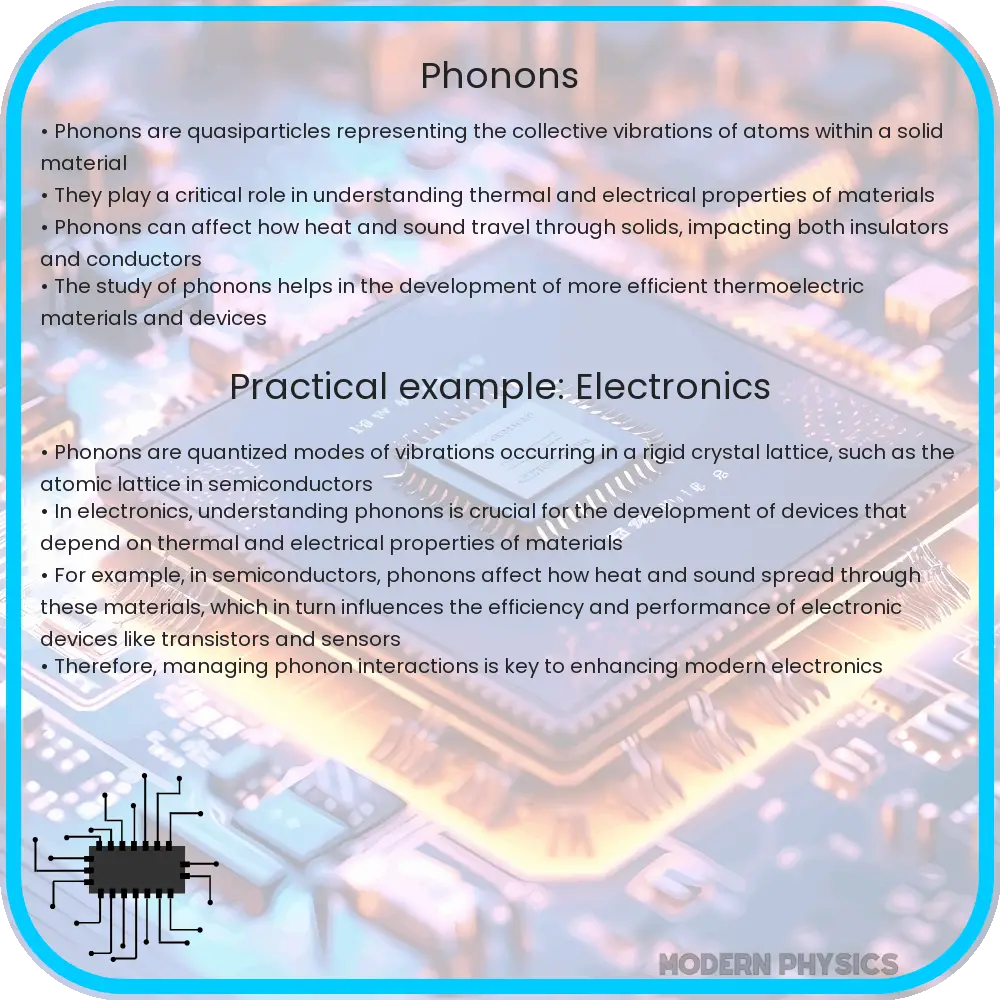Explore the role of phonons in solid state physics, their impact on material properties, and applications in technology and sustainability.

Understanding Phonons in Solid State Physics
Phonons represent a fundamental concept in solid state physics, encapsulating the quantum mechanical descriptions of vibrational energy within a crystalline solid. These quantized vibrations play a pivotal role in determining the thermal, electrical, and mechanical properties of materials. By exploring the properties, dynamics, and applications of phonons, we can gain insights into the behavior of solids at the atomic level.
Properties of Phonons
Phonons are quasiparticles, meaning they are not actual particles but a convenient way of describing energy states in a vibrating lattice of atoms or molecules. A key property of phonons is their discrete energy levels, which can be visualized through their quantization. Unlike classical particles, phonons can only exist at specific energy levels within a solid. This quantization influences the solid’s heat capacity, thermal conductivity, and sound propagation.
Dynamics of Phonons
The dynamics of phonons are governed by the crystal lattice structure and the interactions between atoms. Phonons propagate through the solid in the form of waves, with two main types: longitudinal, where the displacement of atoms is in the direction of wave propagation, and transverse, where the displacement is perpendicular to the direction of wave travel. The velocity and wavelength of these phononic waves determine the solid’s acoustic and thermal properties.
Applications of Phonons
- Thermal Conductivity: Phonons are the primary carriers of heat in non-metallic solids. Understanding phonon dynamics is crucial for designing materials with tailored thermal conductivity, beneficial for thermal management in electronics and insulating materials.
- Electrical Conductivity: In semiconductors, the interaction between phonons and electrons affects the material’s electrical conductivity. By controlling phonon dynamics, it’s possible to engineer semiconductors with specific electrical properties for use in electronic devices.
- Superconductivity: The interaction between electrons and phonons plays a significant role in superconductivity. Phonon-mediated attraction between electrons can lead to the formation of Cooper pairs, a state necessary for superconductivity at low temperatures.
Phonons not only elucidate the microscopic mechanisms underlying solid-state phenomena but also guide the development of advanced materials and technologies. From improving thermal insulators to designing high-efficiency semiconductors, the study of phonons is integral to advancing our understanding and application of solid state physics.
Advanced Research and Technological Innovations
The exploration of phonons extends beyond basic applications, driving innovations in various high-tech fields. For instance, in the realm of nanotechnology, phonon engineering is a critical tool for manipulating heat flow at the nanoscale. This has significant implications for the development of nanoscale electronic devices and thermal management systems. Additionally, in materials science, the study of phonon dispersion relationships aids in the design of materials with desired mechanical and thermal properties, crucial for aerospace, automotive, and construction industries.
Quantum Computing and Phonons
Phonons also find applications in the cutting-edge field of quantum computing. Researchers are investigating phononic crystals for use in quantum computers as they can manipulate phonons in a manner analogous to the manipulation of photons in optical computing. This involves creating structures that can control phonon propagation and interactions, enabling the development of quantum information processing devices that operate using phonons as information carriers.
Environmental Impact and Sustainability
Understanding phonon transport mechanisms is essential for developing more efficient thermoelectric materials, which can convert waste heat into electricity. This research has the potential to significantly reduce energy consumption and carbon emissions, contributing to the development of sustainable energy technologies. Moreover, advanced materials with optimized phonon properties can lead to more efficient insulation materials, reducing energy needs for heating and cooling in buildings.
Conclusion
Phonons play a pivotal role in the physical properties of materials, influencing their thermal, electrical, and mechanical behaviors. The study of phonons is not just a theoretical pursuit but a practical one that has led to significant technological advancements and innovations. From thermal management in electronics and the development of new semiconductors to contributions in quantum computing and sustainable energy solutions, the understanding of phonon dynamics continues to push the boundaries of science and technology. As research in solid state physics advances, the manipulation and control of phonons will undoubtedly unlock new possibilities, furthering our capabilities to develop materials and technologies that address some of the most pressing challenges of our time.
